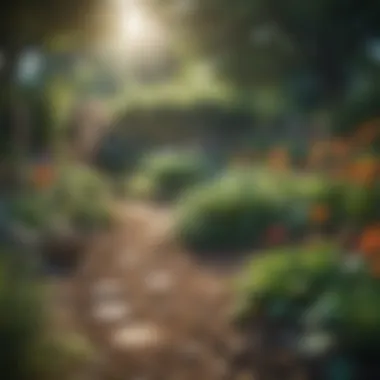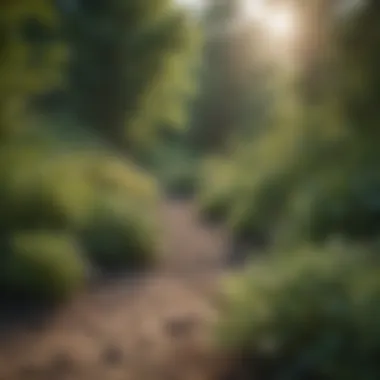Diverse Native Plants of Cincinnati, Ohio: A Deep Dive


Intro
Cincinnati, Ohio, located at the confluence of the Ohio River and the Little Miami River, boasts a rich ecological tapestry. The diverse native plant species found in this region offer insight into local flora and contribute significantly to the ecosystem. In understanding these plants, residents can enhance their gardening practices, preserve local biodiversity, and connect with the historical context of their environment. This article aims to explore the various native plants of Cincinnati, examining their ecological roles, practical applications, and cultural significance.
Animal Profile
General Overview
In considering the ecosystems of Cincinnati, it is essential to acknowledge the interdependence between plants and animals. Many native plants in this region provide food and habitat for various animal species. For example, the Purple Coneflower (Echinacea purpurea) attracts pollinators such as bees and butterflies, while native grasses offer shelter to small mammals and birds. Each species plays a role in maintaining the balance of their habitat.
Habitat and Distribution
Native plants in Cincinnati thrive in a variety of habitats. Forested areas, wetlands, and meadows all harbor unique communities of flora. The Trillium grandiflorum, commonly known as the large-flowered trillium, can be found in woodlands, showcasing its preference for shaded, rich, and moist soil. On the other hand, the Black-eyed Susan (Rudbeckia hirta) flourishes in fields and along roadsides, demonstrating a level of adaptability to different environments.
Fascinating Facts
Unique Traits and Adaptations
The native plants of Cincinnati have developed fascinating adaptations suited to their environments. For instance, the Wild Ginger (Asarum canadense) possesses heart-shaped leaves that help capture sunlight in the understory of forests, while Bluebell (Hyacinthoides non-scripta) relies on moisture and shade to thrive in woodland areas. These adaptations are crucial for their survival and offer a glimpse into the complexities of their ecosystems.
Historical and Cultural Significance
Many native plants have historical ties to the indigenous peoples of the region. The Bur Oak (Quercus macrocarpa), for example, served as a vital resource for early inhabitants in terms of food and construction material. Additionally, the use of various plants in traditional medicine practices further highlights their importance in cultural heritage.
Conservation Status
Current Population Trends
The conservation status of native plants in Cincinnati is a pressing concern. Some species are classified as threatened or endangered due to habitat loss and environmental changes. The Eastern Red Cedar (Juniperus virginiana) has experienced population decline, primarily driven by urban development and land use changes. Tracking these trends is essential for ongoing conservation efforts.
Threats and Challenges
Native flora faces numerous threats, including invasive species, climate change, and urban expansion. Invasive plants can outcompete native species, leading to a decline in biodiversity. Communities must engage in conservation initiatives, such as removing invasive species and restoring native habitats, to protect these vital ecosystems.
Prologue to Native Plants
Native plants hold an intrinsic value in the ecosystem, particularly in regions like Cincinnati, Ohio. They are not merely a backdrop for the urban and natural landscapes but form the foundation of local biodiversity. These plants have co-evolved with the local fauna and flora, establishing a symbiotic relationship that enhances the overall health of the ecosystem. Understanding native plants is essential for fostering a balanced environment.
Definition of Native Plants
Native plants are those species that have evolved in a specific region for thousands of years. They are adapted to local soil types, climate, and the other organisms that share their habitat. In Cincinnati, native plants include a diverse range of flora that plays a crucial role in the ecological balance. Species like the Purple Coneflower and Red Maple are prime examples of plants that are indigenous to this area. Their presence supports wildlife, including insects, birds, and mammals, which rely on these plants for food and habitat.
Importance of Native Plants
The significance of native plants extends beyond mere aesthetics. Here are several key points to consider:
- Ecosystem Support: Native plants are vital in maintaining the health of local ecosystems. They provide food and shelter for wildlife. This, in turn, supports pollinator populations that are essential for crop production.
- Soil Health: These plants contribute to soil formation and prevent erosion. Their root systems improve soil structure, enhancing its ability to hold water and nutrients.
- Water Conservation: Native plants require less water than non-native species once established. This characteristic is particularly important in urban settings like Cincinnati, where water resources may be limited.
Native plants are essential for reducing water use and promoting biodiversity, making them crucial for sustainable landscaping practices.
- Reducing Invasive Species: By planting native species, gardeners can help curb the spread of invasive plants, which often outcompete local flora. This approach helps preserve the natural plant community and its associated wildlife.
By emphasizing the importance of native plants, we gain a deeper understanding of their role in enhancing ecological resilience, which is crucial for the future of local habitats in Cincinnati.
Cincinnati's Unique Ecological Landscape
Cincinnati, Ohio offers a stunning and diverse ecological landscape that significantly contributes to its native plant life. This region is characterized by its varied topography, from the hilly terrain to the river valleys. This topographical diversity creates a range of microclimates which are crucial for the growth of various native species. Understanding Cincinnati’s ecological landscape is essential for several reasons. It allows residents to appreciate their local biodiversity and recognize the importance of native plants in maintaining ecological balance. Also, these plants play a role in soil conservation, water management, and providing habitats for wildlife.
Geographical Overview
Cincinnati is situated in the southwestern part of Ohio, at the confluence of the Ohio and Licking Rivers. This positioning influences the local climate and plant life. The geography includes rolling hills, ravines, and watershed areas that create unique habitats for a range of flora. Notable features include the Cincinnati hills, which rise significantly above the river valleys, leading to variations in soil types and moisture availability. The mesic uplands and moist lowlands support a different array of plant species. Some key geographic aspects include:
- The Ohio River: Acts as a crucial drainage basin and supports various wetland plants.
- Wooded areas: Provide habitats for several species, helping in the balance of local ecosystems.
- Ridges and valleys: Contribute to unique ecosystems as different elevations create diverse conditions for plant growth.


In sum, Cincinnati’s geographical features foster a rich variety of native plant species. This high biodiversity is critical for local ecosystems, making it vital for citizens to educate themselves about their surroundings and the native flora.
Climate Influence on Plant Growth
The climate in Cincinnati is classified as humid subtropical, characterized by warm summers and cold winters. This climatic regime greatly impacts plant growth and distribution. The average temperature varies across the seasons, providing both challenges and opportunities for native plants to thrive. During summer, the heat can promote growth, but extended periods of drought can stress certain species.
The seasonal changes also play an essential role:
- Spring: triggers the awakening of plant life. Many flowers bloom, leading to vibrant landscapes.
- Summer: supports the full growth of plants, where the warm temperatures enable growth rates to peak.
- Fall: offers a display of colors as leaves change, preparing for winter dormancy.
- Winter: brings cold temperatures that can limit growth but also deter certain pests.
Acknowledging the effects of climate on local plant growth helps in understanding which native species are best suited for planting based on weather patterns.
This interplay between climate and geography showcases why it is crucial to consider both factors when discussing Cincinnati’s native plants. Community efforts towards gardening and conservation should reflect an awareness of these elements to enhance local biodiversity and ecological health.
Common Native Plants in Cincinnati
Native plants play a vital role in shaping Cincinnati's ecology and creating a harmonious environment. They help support local wildlife, improve soil quality, and reduce the presence of invasive species. Understanding and promoting common native plants in this region can result in a flourishing ecosystem that benefits everyone.
Wildflowers
Purple Coneflower
The Purple Coneflower is a standout among Ohio’s native flora. Its vibrant purple petals attract various pollinators, which contribute significantly to local biodiversity. As a drought-resistant perennial, this flower thrives in poor soils. Its key characteristic is its ability to withstand dry spells, making it a sustainable choice for gardeners. The unique feature of the Purple Coneflower is its conical seed heads, which are a food source for birds. However, it can require some maintenance to prevent it from spreading excessively in garden settings.
Black-Eyed Susan
Black-Eyed Susan is another essential native wildflower in Cincinnati. Known for its yellow petals and dark center, it adds a cheerful splash of color to any landscape. This flower is a favorite among gardeners for its hardiness and resilience. It promotes biodiversity by attracting butterflies and bees. A distinctive feature of Black-Eyed Susan is its long blooming season, lasting from summer into fall. While it is prolific and easy to grow, gardeners should monitor its growth to avoid overcrowding in flower beds.
Butterfly Weed
Butterfly Weed, with its bright orange blossoms, is crucial for attracting butterflies, particularly the Monarch. This plant thrives in sunny, well-drained areas and is particularly significant in supporting butterfly populations. The key characteristic of Butterfly Weed is its deep taproot, which makes it drought-resistant once established. Its unique feature is its ability to flourish in poor soil conditions, making it ideal for low-maintenance gardens. However, it can take time to establish, so patience is necessary.
Grasses
Little Bluestem
Little Bluestem is a prominent grass species found in Cincinnati. Its distinctive blue-green color provides a unique aesthetic and supports wildlife by offering cover and food. This grass is drought-tolerant and adapts well to various soil types. The noteworthy characteristic of Little Bluestem is its ability to remain upright even in windy conditions, maintaining landscape interest throughout the winter. However, it may require some pruning in the spring to encourage new growth.
Big Bluestem
Big Bluestem is often referred to as a key component of the tallgrass prairie ecosystem. Its tall stature and striking appearance make it a desirable choice in native plant gardening. This plant provides habitat for various species, supporting the local ecology. A key feature of Big Bluestem is its deep root system, which aids in soil retention and prevention of erosion. While it is beneficial, it can become invasive if not monitored properly in gardens.
Sideoats Grama
Sideoats Grama is a grass native to the Midwest, known for its unique seed heads that hang on one side of the stem. This form adds visual interest in gardens, making it a popular choice among landscape designers. It is adaptive and grows in a variety of soil types. The significant aspect of Sideoats Grama is its drought tolerance, making it suitable for low maintenance landscapes. However, in dense plantings, it may compete with other species, so careful planning is necessary.
Shrubs
American Hazelnut
The American Hazelnut is a versatile shrub that plays a vital role in providing food and shelter for wildlife. It is highly valued for its edible nuts, which are a food source for various birds and mammals. The key characteristic of this shrub is its attractive growth habit, making it suitable as an ornamental plant in gardens. Unique to the American Hazelnut are its beautiful catkins, which appear in early spring. However, it may suffer from pests like the Eastern Filbert Blight, which gardeners need to manage appropriately.
Ninebark
Ninebark is recognized for its distinctive peeling bark and round clusters of flowers. This shrub serves as a visual focal point in gardens throughout the growing season. It's highly regarded for its adaptability to different soil types and conditions. The unique feature of Ninebark is its diverse habitats, supporting various insects and birds. While it is resistant to many diseases, it can attract harmful pests, so regular monitoring is essential.
Red Osier Dogwood
Red Osier Dogwood is known for its striking red stems, which provide an eye-catching feature in winter landscapes. This shrub plays an important role in erosion control and habitat stability. Its primary characteristic is how it thrives in wet, lowland areas. A unique feature is its creamy-white flowers that attract pollinators in the spring. While it is beneficial for sediment stabilization, it can become thicket-forming in ideal conditions, which can be a downside for small garden settings.
Trees
Red Maple


The Red Maple is celebrated for its stunning fall foliage, making it a desirable tree for landscaping. This native tree thrives in a variety of soil types and offers habitat for numerous bird species. Its key characteristic is its rapid growth rate, allowing it to reach heights quickly. The unique feature of Red Maple is its adaptability to wet conditions, making it suitable for rain gardens. However, it is susceptible to certain diseases, requiring careful management.
White Oak
White Oak is an iconic tree in Cincinnati's landscape. Its robust structure and long lifespan contribute significantly to the ecosystem. This tree is known for its acorns, which are a critical food source for various wildlife. The notable characteristic of the White Oak is its broad canopy, providing ample shade. Its unique feature is its high tolerance to drought and a variety of soil conditions, making it an excellent choice for diverse landscapes. However, it can grow quite large, necessitating ample space in the garden.
Hackberry
Hackberry is a hardy tree that plays an essential role in supporting local fauna. It often thrives in urban areas, adapting well to disturbed environments. Its key characteristic is its ability to attract diverse bird species. A unique feature of Hackberry is its small, edible berries, which provide food for many animals. However, it can be prone to pests and requires monitoring to maintain health.
Benefits of Using Native Plants
Native plants have a crucial role in maintaining the health and stability of local ecosystems. In Cincinnati, utilizing these species in landscaping and gardening not only supports the environment but also enriches the community. Here, we will explore three core benefits: supporting local wildlife, enhancing soil and water health, and reducing invasive species.
Support for Local Wildlife
Native plants are integral to the survival of local wildlife species. They provide essential habitats and food sources, forming the basis of the food chain. Many insects, birds, and small mammals rely on native flora for sustenance.
Utilizing native plants can:
- Attract pollinators like bees and butterflies, which are vital for plant reproduction.
- Provide shelter and nesting sites for birds and small animals.
- Support the overall biodiversity of an ecosystem by favoring species that have co-evolved with local wildlife.
By planting native species, residents can foster an environment that encourages wildlife to thrive. This further enhances the ecological balance of the area, benefiting everyone involved.
Soil and Water Health
Integrating native plants into gardens contributes positively to soil and water health. These plants are adapted to local soil types and climate conditions, promoting a natural balance. They require less water and fertilizer compared to non-native varieties, making them more sustainable.
Benefits for soil and water include:
- Natural erosion control due to deep-root systems that stabilize soil.
- Reduced run-off, which minimizes water pollution as native plants efficiently absorb rainfall.
- Improved nutrient cycling, as these plants can enhance soil structure and fertility over time.
As a result, utilizing native species leads to healthier and more resilient landscapes.
Reduction of Invasive Species
Invasive plants often threaten native biodiversity by outcompeting native flora for resources. Introducing native plants into landscaping can significantly reduce these invasions. Native species tend to resist pests and diseases that affect non-native counterparts, creating a more balanced ecosystem.
Key points in reducing invasive species include:
- Establishing native plant communities that can naturally outcompete invasive species.
- Deterring wildlife that prefers non-native species, as local fauna are adapted to native plants.
- Reinforcing local ecosystems by promoting the plants species that belong naturally in the region.
Challenges Faced by Native Plants
Native plants in Cincinnati encounter numerous challenges that threaten their survival and ability to thrive. Understanding these challenges is crucial for fostering the rich diversity of flora that defines the region's unique ecology. As residents become more aware of these hurdles, they can take appropriate action to support local ecosystems. The primary challenges include urbanization, invasive species, and the effects of climate change.
Urbanization and Habitat Loss
Urbanization significantly alters natural habitats, leading to fragmentation and loss of native plant populations. As Cincinnati expands, green spaces are often replaced by roads and buildings. This process diminishes not only the area in which native plants can grow but also disrupts their relationships with local wildlife. Plants such as the Purple Coneflower are directly impacted as their habitats are destroyed, depriving pollinators of food sources. Furthermore, the loss of trees like the White Oak can result in decreased shelter and nesting sites for birds.
Key Points:
- Fragmentation reduces genetic diversity among plant populations.
- Native plant communities lose their natural interactions with local wildlife.
- Urban heat islands exacerbate stress on native plants, affecting their growth and reproduction.
Invasive Species Competition
Invasive species pose a formidable challenge to native plants by outcompeting them for resources. Species such as Japanese Knotweed or Buckthorn can quickly dominate landscapes, limiting space, light, and nutrients available to native flora. This competition can lead to a significant decline in native biodiversity. Additionally, some invasive species possess traits that allow them to thrive in disturbed environments, giving them an advantage over native plants that are less resilient to such changes.
Key Considerations:
- Invasive plants can alter soil chemistry, impacting the growth of native plants.
- They often do not provide the same ecological functions as native species, affecting wildlife that rely on them.
Climate Change Effects


Climate change represents a long-term threat to native plant communities in Cincinnati. Shifts in temperatures and precipitation patterns affect plant biology and growth cycles. For instance, increasing temperatures may lead to earlier blooming times for certain species. Such changes can disrupt pollinator schedules, resulting in mismatched interactions. Moreover, altered rainfall patterns can lead to periods of drought or excessive moisture, both of which can be detrimental to native plants, such as the Sideoats Grama.
Potential Impacts:
- Changes in local climate may allow invasive species to establish more effectively.
- Native plants may struggle to adapt quickly enough to the surrounding environmental changes.
Understanding these challenges is vital for conservation efforts and native plant gardening. By recognizing the obstacles faced by native flora, individuals and communities can better promote their support and ensure a thriving ecological landscape in Cincinnati.
Gardening with Native Plants
Gardening with native plants offers a multitude of benefits. These plants are well adapted to local soil and climate conditions. They require less water, are more resistant to pests, and can thrive without additional fertilizers. Native plants also enhance local biodiversity and provide essential habitats for wildlife, particularly pollinators like bees and butterflies. Additionally, they can help improve soil health and reduce the risk of erosion.
Designing Native Plant Gardens
When planning a native plant garden, it is vital to consider the specific conditions of your site. Understanding soil type, light exposure, and moisture levels will guide plant selection. Grouping plants with similar needs promotes healthier growth and reduces maintenance. Consider using layers in your garden: plant taller species at the back and shorter ones in front. This creates visual interest and ensures that sunlight reaches all plants. Choosing plants such as Purple Coneflower, Black-Eyed Susan, and Little Bluestem can create vibrant displays that attract various wildlife.
Key Design Principles:
- Site Assessment: Evaluate soil, light, and moisture conditions.
- Layering: Use varying heights to promote aesthetics and ecology.
- Grouping: Plant in clusters for better maintenance and impact.
Maintenance Practices
Maintaining a garden of native plants requires less effort than traditional landscapes. Initial establishment may require regular watering, but once these plants are settled, they generally need less care. Mulching can help suppress weeds and retain moisture. Periodic pruning may be necessary to remove dead or diseased growth. Monitoring for invasive species is crucial, as these can disrupt the balance of the ecosystem.
Simple Maintenance Tips:
- Watering: Ensure adequate moisture during the first growing season.
- Mulching: Use organic mulch to retain soil moisture and suppress weeds.
- Pruning: Remove dead or diseased parts to promote healthy growth.
Gardening with native plants not only enhances your landscape but also supports local wildlife and promotes environmental sustainability.
By focusing on native plant gardening, individuals can cultivate a resilient landscape that thrives naturally, benefitting both the gardener and the local ecosystem.
Conservation Efforts in Cincinnati
Conservation efforts in Cincinnati play a crucial role in preserving the native plant species that are integral to the area's ecology. Understanding these initiatives helps illustrate the community's commitment to protecting its natural heritage. Conservation is not only about safeguarding plants but also about fostering a balance between urban development and the maintenance of biodiversity.
Local Organizations and Initiatives
Several organizations in Cincinnati are actively involved in preserving native plants and their habitats. These groups work diligently to promote the understanding and appreciation of native flora among residents. For example, the Cincinnati Nature Center offers various programs and resources aimed at educating the public on local biodiversity and plant conservation.
Other initiatives include:
- Great Parks of Hamilton County: This organization focuses on the preservation of local parks and natural areas, ensuring that native plant species thrive in these environments.
- Cincinnati Parks: This city agency engages in numerous activities aimed at restoring native landscapes within urban parks.
These organizations often collaborate with local schools and communities to host events, volunteer days, and workshops centered around native plant species and their ecological significance.
Community Engagement and Education
Community engagement is essential for successful conservation efforts. Educating residents about the importance of native plants can lead to increased participation in preservation initiatives. Many programs are in place to inform students, families, and community members about the benefits of native gardening and habitat restoration.
Workshops and educational resources cover such topics as:
- Native plant gardening: Teaching community members how to cultivate and nurture native species in their own yards.
- Wildlife habitats: Showcasing how native plants support local wildlife, including pollinators like bees and butterflies.
Engaging the community fosters a sense of ownership and responsibility toward local natural resources. It encourages more individuals to consider how their actions impact the environment.
Culmination
Summary of Key Points
- Native plants are crucial to enhancing biodiversity and supporting local ecosystems.
- They adapt well to local soil and climate conditions, requiring less maintenance than non-native species.
- Gardening with native plants promotes sustainable landscaping practices, aiding in soil and water conservation.
- Various organizations and community initiatives in Cincinnati work towards the conservation and education of native species.
- The collaboration between residents and conservation efforts is vital for sustaining Cincinnati's natural heritage.
Call to Action for Residents
Residents of Cincinnati are encouraged to actively participate in preserving and promoting native plant species. Consider incorporating native plants into your gardens, as they not only enhance the local landscape but also support wildlife.
- Educate yourself about the local flora and their benefits.
- Engage with local conservation groups to learn more and to connect with like-minded individuals.
- Volunteer for local initiatives focusing on restoration and education about native plants.
- Share knowledge within your community about the importance and advantages of utilizing native species in landscaping.
By taking these steps, each resident can contribute to a healthier environment and foster deeper connections with Cincinnati's rich natural heritage.















